- 現在位置
- トップ > 白書・統計・出版物 > 白書 > 文部科学白書(英文) > 2017年文部科学白書(英文) > Special Feature 1:Development of Cultural Policies that Promote Social and Economic Values
Special Feature 1:Development of Cultural Policies that Promote Social and Economic Values
Section 1 Enactment of the New Basic Act on Culture and the Arts and Formulation of the Basic Plan on the Promotion of Culture and the Arts
1.Enactment of the New Basic Act on Culture and the Arts
In June 2017 the Basic Act for the Promotion of Culture and the Arts that is the basic law for promotion of culture and the arts was revised into the Basic Act on Culture and the Arts (“the Basic Act”). The Basic Act on Culture and the Arts aims to promote the independent activities related to culture and the arts. The act is designed to comprehensively and systematically promote policies related to culture and the arts, through contributing to realization of a vigorous society and lifestyles rich in spirit. The revisions further extend the scope of the fields for promotion of policies related to culture and the arts to include: tourism, town development, international exchange, social welfare, education and industry. The revision also stresses the importance of linking various new values created through culture and the arts to succeed, develop, and create new culture and the arts.
New articles have been added which stipulate the role of cultural/arts organizations, in addition to promoting collaboration and cooperation among the central government, incorporated administrative agencies, cultural/arts organizations and private businesses. The revision is made in articles for the basic measures related to culture and the arts, by adding the Japanese Kumiodori dance as an example of traditional performing arts, and promotion of food culture. The new act also stipulates support for arranging arts festivals, and creative activities by senior citizens and people with disabilities.
2.Development of the Basic Plan on the Promotion of Culture and the Arts (the First Plan)
The Basic Plan on the Promotion of Culture and the Arts (“Basic Plan”)is formulated based on the Basic Act with the aim of comprehensively and systematically promoting policies related to culture and the arts.
In response to the enactment of the Basic Act in June 2017, the Minister of Education, Culture, Sports, Science and Technology consulted the Council for Cultural Affairs on the “Basic approach to comprehensive and systematic promotion of policies related to culture and the arts - toward development of the Basic Plan on the Promotion of Culture and the Arts (First Plan)” in the same month of the same year.
The Council held 15 general, Cultural Policy Committee and Working Group on the Basic Plan meetings and 14 sectoral subdivision and working group meetings for vigorous deliberation while inviting opinions of a wide range of people involved in culture and the arts through hearings with cultural/arts organizations, for example. The Council submitted a report “about the Basic Plan on the Promotion of Culture and the Arts (First Plan)” at its general meeting in February 2018. Based on the report, and after coordination on the draft of the basic plan with relevant government offices at the Council for the Promotion of Culture and the Arts that was set up based on the Basic Plan, the Cabinet Decision was made on “Basic Plan on the Promotion of Culture and the Arts ~ Create the future by making full use of the diverse values of culture and the arts ~” (for 5 years from Fy2018 to FY2022)on March 6 of the same year. The government will strongly promote culture and arts policies as national strategy based on the Basic Plan toward realization of a Nation Based on Culture and the Arts.
The outline of the Basic Plan is introduced below (Fig. 1-1-1).
(1)The Situation, etc. Around Policy on Culture and the Arts of Japan
The Basic Plan clearly articulated that culture and the arts as social assets of the whole nation and humanity are source of creative economic activities as well as the foundation of sustainable economic development and facilitation of international cooperation, and have social and economic values in addition to their intrinsic values.
It also mentions the need to implement comprehensive cultural and arts policies in coordination with related fields in response to social requirements to adapt to the changes in social conditions such as declining birthrates and aging, globalization and the rapid progress of IT. Furthermore, it suggests that the Tokyo 2020 Olympic and Paralympic Games are at once a sports festival and a culture festival, and a great opportunity to communicate the value of Japanese culture and the arts to the world and widely publicize the creation of new values through culture and the arts.
(2)Goals of Policies on Culture and the Arts
In order to clear a path for our future by creating diverse values (intrinsic and social/economic values)based on the spirit of the Basic Act, the Basic Plan sets force the following four goals (visions of policy on culture and the arts):
- Vision 1: The Creation, Development and Succession of Culture and the Arts and Education
The creation, development and succession of culture and the arts are ensured and everyone can enjoy rich education in culture and the arts and opportunities to participate in cultural and artistic activities. - Vision 2: A Creative and Vibrant Society
Effective investments are made in culture and the arts, creating innovations and contributing to a national brand through international exchange in and transmission of culture and the arts, and thereby a creative and vibrant society has been formed. - Vision 3: A Spiritually Affluent and Diverse Society
Everyone participates in society through culture and the arts, which spreads mutual understanding and creates a spiritually affluent society where diverse values are respected. - Vision 4: Platforms to Promote Culture and the Arts in Regions
Platforms to promote the local regional culture and arts are formed all over the country. Diverse people, cultural/arts organizations, various institutions cooperate to form sustainable and resilient regional cultural communities.
(3)The Basic Direction of Cultural and Artistic Policies over the Next Five Years
In order to realize the four visions above in the medium to long term, the Basic Plan sets forth the following six strategies as the basic direction of cultural and artistic policies over the next five years from 2018 to 2022.
- Strategy 1 Creation, Development and Succession of Culture and the Arts and Fulfillment of Rich Education in Culture and the Arts
Promote creation and development of culture and the arts, ensure succession of our excellent culture and the arts to the next generation and also ensure rich education in culture and the arts. - Strategy 2 Effective investment in culture and the arts and realization of innovation
Utilize our rich cultural and artistic resources through effective investment in them. Realize innovations through culture and the arts by promoting emergent culture such as combined fields, utilization of information and communication technologies, lifestyle culture including food, shelter and clothing, tourism taking advantage of culture and the arts, development of industries and markets related to culture and the arts, for example. - Strategy 3 Promotion of international cultural exchange and cooperation, contribution to mutual understanding and national branding through culture and the arts
Taking the opportunity of the Tokyo 2020 Games, implement a wide variety of cultural programs at home and abroad to promote international cultural exchange and cooperation, while strategically and actively transmitting Japanese culture to contribute to mutual understanding and national branding through culture and the arts. - Strategy 4 Fostering social values through promotion to form diverse values and an inclusive environment
Encourage development of an environment where everyone from children to elderly citizens, people with disabilities, and foreigners, can easily enjoy opportunities to participate in cultural and artistic activities throughout their entire lives in every community. Foster also the social value of culture and the arts by promoting diverse values and an inclusive environment in the communities through culture, which includes promotion of diverse culture and the arts in the communities. - Strategy 5 Securing and Fostering Diverse and Highly Skilled Professionals
Secure highly skilled professionals who are diverse in age and gender, while developing human resources through education, training, etc. according to their carrier stages. - Strategy 6 Building of Platforms Promoting Regional Cooperation and Collaboration
Strengthen collaborations among relevant organizations including the central government, incorporated administrative agencies, local governments, cultural/arts organizations, cultural facilities and private businesses. Build platforms promoting regional cooperation and collaboration while carrying out comprehensive culture and arts policies (a framework for relaxed cooperation and collaboration among related organs, etc. on even ground)
In order to ensure effective and steady promotion of the Basic Plan, there are about 170 measures including related measures of relevant government offices and the items added as examples of basic measures in the Basic Act. They are basic measures corresponding to the six strategies above.
(4)Establishment, etc. of Evaluation and Verification Cycles
In order to ensure steady and continuing implementation of measures to promote culture and the arts based on the First Basic Plan and improve accountability to the public, the plan sets forth establishment of evaluation and verification cycles using 36 evaluation indicators (PDCA cycles).
Every fiscal year, follow-up on the progress of the plan is done based on 36 evaluation indicators such as cultural GDP. Mid-term evaluation will be conducted during FY2020. The plan indicates that this process should stress not only quantitative but also qualitative evaluation while paying careful attention to the characteristics of each field of culture and the arts and that the objective is not to achieve the indicators.
In order to ensure the effectiveness of PDCA cycles of culture and arts policy, it is important to establish a system for policy making and evaluation. To this end, the plan indicates the need for development of functions and networks necessary for collection, survey and analysis of information and various data on culture and the arts at home and abroad.
(5)Toward steady implementation of the Basic Plan
In order to realize a Nation Based on Culture and the Arts under the Basic Act, it is necessary for the government to steadily implement the Basic Plan in a unified manner. It is also important to ensure cooperation and collaboration among the central government, incorporated administrative agencies, local governments, cultural/arts organizations and private businesses. MEXT will make necessary efforts based on the Basic Plan in continued cooperation and collaboration with relevant government offices and other related organizations.
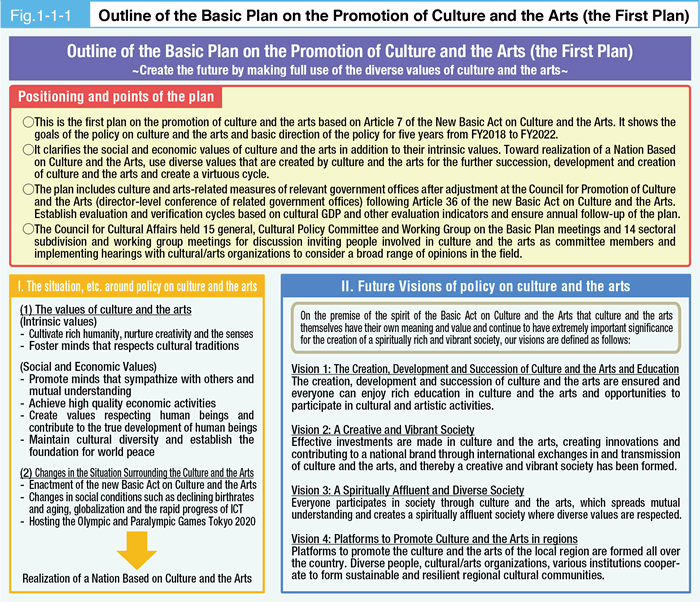
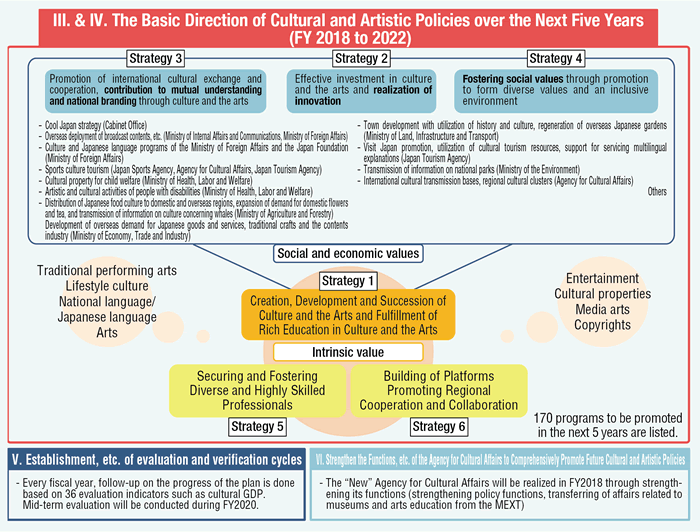
3.Formulation of Cultural Economic Development Strategy
It is now necessary to go beyond the past culture promotion by the Agency for Cultural Affairs and develop plans for economic expansion based on the cross-sectoral integration and strengthening of culture-related measures conducted by the Cabinet Secretariat and other government offices, which include the Olympic and Paralympic Games Tokyo 2020, industry, tourism, towns/people/jobs, etc. For such comprehensive planning and coordination it is necessary to develop a system beyond the organization of the agency. To this end a team gathering staff of related government offices was set up under the Cabinet Secretariat in March 2017. In addition, the cabinet decided to develop a Cultural Economic Development Strategy in the “Basic Policy on Economic and Fiscal Management and Reform 2017” and the “Growth Strategy 2017” of June 2017. In response, the Cabinet Secretariat and the Agency for Cultural Affairs formulated a Cultural Economic Development Strategy with the aim of (1)expanding strategic investments in culture by the central and local governments, private enterprises and individuals, (2)creating new values through creative activities starting from culture in collaboration with industry and other sectors, and (3)building an mechanism of independent and sustainable development through effective reinvestments of created values in preservation, succession and new creation of culture and the arts. In its formulation, basic concepts and prioritized perspectives were organized as “Six viewpoints” while initiatives to be promoted with special focus were identified as “six priority strategies” (see Fig. 1-1-2 to 1-1-4). For the future, measures will be promoted based on the Cultural Economic Development Strategy.
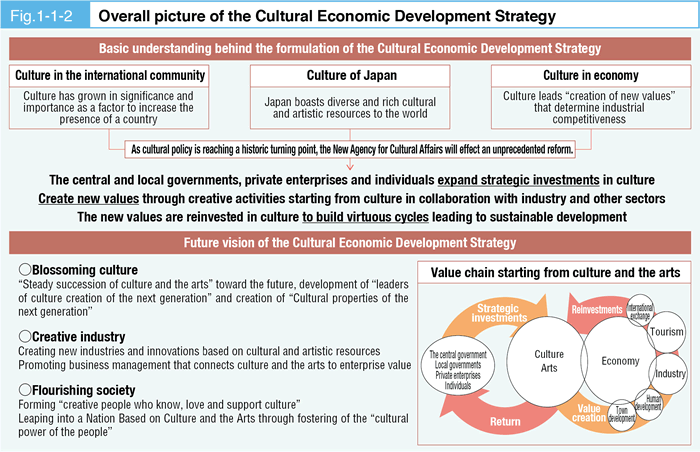
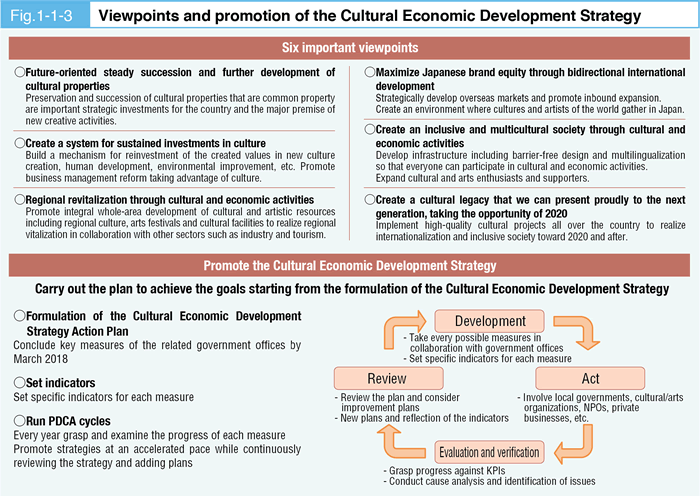
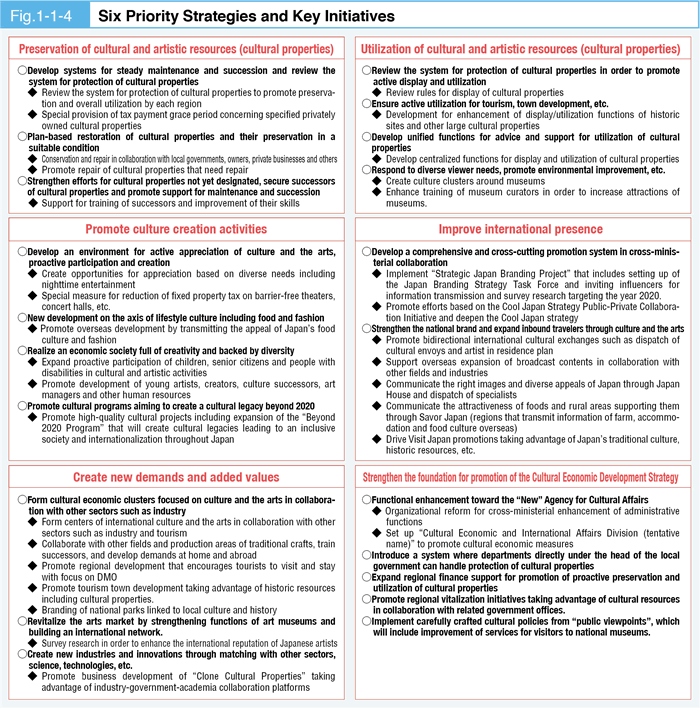
Section 2 Functional Enhancement toward Development of the New Agency for Cultural Affairs and Preparation for Full-Scale Relocation
1.Relocation of the Agency for Cultural Affairs
In an effort to correct Tokyo Centralization, the Headquarters for Overcoming Population Decline and Vitalizing Local Economy in Japan determined the Basic Policy on the Transfer of Governmental Organizations to Regional Areas in March 2016, having discussed the relocation of government organizations while taking into account proposals made by the various prefectures.
The policy states that the Agency for Cultural Affairs will be relocated to Kyoto within the next several years, on the presumption that its functions such as diplomatic activities, dealing with Diet debates, and policy planning (including coordination with other ministries)will be maintained. It is also decided that as well as relocating, the Agency will enhance its capabilities to meet new policy needs such as regional vitalization and also to utilize cultural properties.
Following this, a Council for the Relocation of the Agency for Cultural Affairs, made up of the relevant ministries and agencies as well as Kyoto Prefecture and City, was created in April 2016. In July 2017, the Council concluded 1)a general organizational framework for the relocation of the Agency for Cultural Affairs to Kyoto, 2)that the new location should be the main building of the current Kyoto Prefectural Police Headquarters (to be leased after repairs and additions by Kyoto Prefecture), and 3)that the relocation should be completed by FY2021 at the latest.
2.Setting up the Headquarters for Vitalizing Regional Cultures
In April 2017 before the full-scale relocation, the Headquarters for Vitalizing Regional Cultures consisting of about 40 members was set up in Kyoto with the cooperation of Kyoto Prefecture, Kyoto City, the Kyoto Chamber of Commerce and Industry, the Union of Kansai Governments, the Kansai Economic Federation and other local organs. The Headquarters has three groups: Policy Coordination and Policy Research; Lifestyle, Culture and Arts, and; Promotion of Inter-regional Cultural Tourism and Regional Development. These groups have been conducting affairs and projects that address new policy needs as expected of the Agency by utilizing local knowledge and knowhow.
Specifically, the Headquarters has been considering survey research and measures on lifestyle and culture, developing culture tourism and town development models taking advantage of cultural properties, and supporting development of culture tourism centers. To address new policy challenges, it has been conducting study and analysis of economic effects of culture as well as survey research on policy issues jointly with universities and other research institutes, and holding the All Japan Traditional Culture Festival of High School Students and other projects in collaboration with the local governments, etc. Through these efforts, the Headquarters will ensure further cooperation with local stakeholders, foster momentum for relocation of the Agency to Kyoto and for making plans based on local people’s viewpoints including industry.
3.Functional Enhancements toward Development of the New Agency for Cultural Affairs
In order to develop a system suitable to the new Agency for Cultural Affairs through its organizational reform and functional enhancements toward the full-scale relocation to Kyoto, the bill to amend part of the Act for Establishment of the Ministry of Education, Culture, Sports, Science and Technology was submitted to the 196th Session of the Diet. The bill changes the duty of the Agency to “comprehensive promotion of cultural policies” and added (1)planning and promotion of basic policy for culture and (2)adjustment of culture related affairs of relevant administrative organs to the affairs under the Agency. The bill also provides that the processes related to setting standards of arts education in schools and those related to promotion of museums are relegated from MEXT to the Agency for Cultural Affairs. These amendments will improve the system for the agency to lead Japan’s culture administration and are expected to become a major step toward a Nation Based on Culture and the Arts (scheduled for enactment on October 1, 2018).
Starting from autumn of 2018 when the Agency marks the 50th anniversary of its foundation, the new Agency for Cultural Affairs in cooperation with relevant government offices will enhance its functions including strengthening of responses for tourism promotion and regional vitalization taking advantage of cultural resources, improvement of culture communication, promotion of lifestyle and culture and promotion of culture creation and survey research on cultural policies.
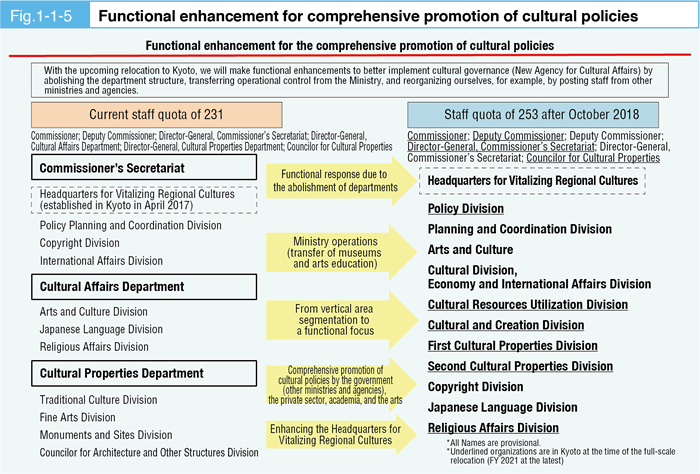
4.Preparation for the full-scale relocation
Based on the recognition that the agency needs an enhancement of its “regional and local” perspective, and that it has a challenge to strengthen its ability to convey messages, the agency has been taking actions at the Headquarters for Vitalizing Regional Cultures set up in Kyoto ahead of the full-scale relocation.
In addition, the agency will continue verification of the preceding relocation in order to build an efficient system both in Kyoto and Tokyo. The efforts include review of operations themselves and their entire process (e.g. operational efficiency using ICT)and sorting of internal decision making processes.
In accordance with the agreement at the Council for the Relocation of the Agency for Cultural Affairs, the agency will prepare for the smooth full-scale relocation scheduled in FY2021, in continued collaboration with relevant government offices and parties concerned, including those in Kyoto.
Section 3 Reform of the System for Protection of Cultural properties ~ Preservation and Utilization Suited to the Age to Come toward Sure Succession of Cultural Properties
Cultural properties were created in relation with the life of people and the climate against various historical backgrounds, and have been protected and handed down to us. They are valuable assets of the people. However, there is a lack of successors of cultural properties due to depopulation, declining birthrate and aging population. Prevention of loss and dispersion of cultural properties is a pressing issue. As individual regions are working on their town development, the momentum is rising to discover and utilize distinctive cultural properties of the regions. It is necessary to build a system for entire regions to work on succession of cultural properties including those not yet designated, while utilizing them for town development.
For this purpose, in May 2017 the Minister of MEXT asked the Council for Cultural Affairs for comprehensive review of the system for protection of cultural properties in order to take necessary measures ahead in advance (“preservation and utilization of cultural properties in the future”.)In response, the Planning and Study Committee set up at the Subdivision on Cultural Properties of the Council conducted the first comprehensive review of initiatives viewing cultural properties and their environment as one unit and of regional development. The report: “Preservation and Utilization Suited to the Age to Come toward Sure Succession of Cultural Properties (the first report)” was submitted in December of the same year.
Based on the report, “the bill to amend part of the Law for the Protection of Cultural Properties and the Act on the Organization and Operation of Local Educational Administration” was decided by the Cabinet on March 6, 2018 and enacted on June 1, 2018 after it was deliberated at the Diet.
The amended acts provide three overall frameworks for promotion of plan-based preservation and utilization of cultural properties in the regions and strengthening of the driving power of local administration for protection of cultural properties.
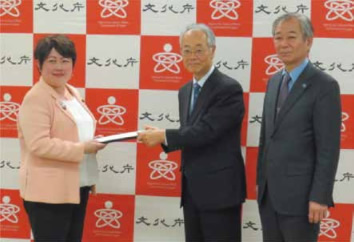
The report
1.Comprehensive and Plan-based Preservation and Utilization of Cultural Properties in the Communities
First, each prefecture may formulate the outline of comprehensive measures for preservation and utilization of cultural properties. The outline must include basic policy for preservation and utilization of cultural properties, activities for each wide area, response to disaster occurrences and support to small municipalities. Prefectures are expected to take an active part in wide-area collaboration beyond municipalities and support for municipalities that are yet to formulate their regional plans for the preservation and utilization of cultural properties described below (“Regional Plan”).
If the prefecture has formulated its outline, municipalities may formulate their comprehensive plan for preservation and utilization of cultural properties (Regional Plan)and apply for authorization by the central government. Regional Plan shall include:
- Basic policy for preservation and utilization of cultural properties in the area of the municipality
- Content of the measures taken by the municipality for preservation and utilization of cultural properties in the area of the municipality
- Matters concerning survey to assess the cultural properties in the area of the municipality
- Plan period, etc.
When creating the plan, the municipality shall endeavor to reflect opinions of residents, is required to hear opinions of the local council for protection of cultural properties, and may organize a consultative body. The consultative body is an organization where the municipality, prefecture, cultural property owners, private sector groups supporting preservation and utilization of cultural properties (“supporting organization for preservation and utilization of cultural properties” described below), academic experts, chambers of commerce and industry, tourism organizations and other various human resources whose participation the municipality finds necessary.
The system for proposal to register cultural properties to the central government is established as a legal effect of the government’s authorization of the regional plan. Under this system, regions study how to protect undesignated cultural properties that are found as a result of survey and may propose registration in the registration book by the central government if it is found appropriate. This will further strengthen the cooperation between the government and the regions in protection of undesignated cultural properties found in the regions. Authority for some affairs including permission for alteration of a current state of nationally designated cultural properties (excluding material affairs)has been transferred from the Commissioner of the Agency to local governments. In addition to prefectures and cities, towns and villages whose regional plan has been authorized may execute such affairs as an exception. To do this, the towns/villages are required to stipulate their intension to execute the affairs in their plan and be certified by the state. Concrete procedures will be provided by ordinances, etc. in the future.
The Agency for Cultural Affairs plans to present operational guidelines for the basic approach in order to help prefectures and municipalities in their consideration of outlines and regional plans respectively.
Furthermore, municipalities may designate private sector groups that provide consultation to cultural property owners and carry out survey research in the region as “supporting organization for preservation and utilization of cultural properties” (“supporting organization”.)Supporting organizations are expected not only to preserve and utilize cultural properties in the area but also to provide information and consultation to people who engage in businesses for preservation and utilization and to perform services such as management and repair of cultural properties by request from the owner. They may propose formulation and alteration of a regional plan to the municipality. Supporting organizations are “juridical persons and other equivalent organizations” and may include preservation societies and other private organizations.
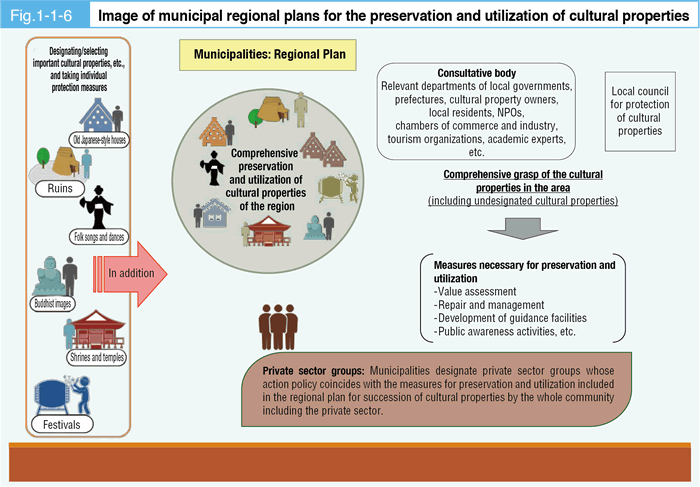
2.Review of the System for Preservation and Utilization to Ensure Succession of Individual Cultural properties
The following part introduces the content of the amended act concerning individual cultural properties.
The current system for designation, selection and registration of cultural properties and actions for repair has worked very effectively for protection of cultural properties. This amendment aims, while maintaining the present system, to visualize the value, preservation and utilization of cultural properties and adds a mechanism for plan-based implementation of appropriate actions.
Specifically, owners or management associations of nationally designated cultural properties, etc. may formulate a “preservation and utilization plan of cultural properties” of the properties and apply for its authorization by the state. A “preservation and utilization plan of cultural properties” shall include the current state of the cultural properties (their location, owner and condition; state of successor training, etc.), points for preservation and management, policy for repair, utilization and succession of preservation. The agency plans to show its detail through guidelines, etc. (for the content of deliberation at the Council for Cultural Affairs up to this time, see Fig. 1-1-7).
Planning has been promoted for buildings, special historic sites, special places of scenic beauty, special natural monuments. This is expanded to other types of cultural properties and planning is promoted by setting up a state authorization system.
A “preservation and utilization plan of cultural properties” is expected to list planned repair and improvement activities. Implementation of the plan will need separate procedures including permission for change of existing condition. The revised act provides flexible procedures such as post fact notification instead of the usual individual permission if the content and specific parts of repair, etc. are identified in the preservation and utilization plan of cultural properties, the action is found to be appropriate and the plan has been authorized by the Commissioner of the Agency. For cases where the owners prepared a preservation and utilization plan of cultural properties of fine arts and crafts designated and registered as Important Cultural Properties or Registered Tangible Cultural Properties, received state authorization, entrusted them to a museum and made them open to public, a special measure is provided for grace period for payment of the inheritance tax on the fine arts and crafts. This measure is expected to store precious cultural assets in an appropriate environment of art museums, etc. and expand opportunities for a wide range of people to appreciate the appeal of cultural properties.
In addition, the custodian system for preservation and utilization of cultural properties instead of the owner will be reviewed in order to develop a system that can respond to difficulty to ensure adequate protection of cultural properties by the owner due to aging or other reasons. Currently owners of cultural properties may select a custodian “where special circumstances exist”, which will be expanded to “where it is necessary for proper management” of the cultural property to improve the system to support owners of cultural properties.
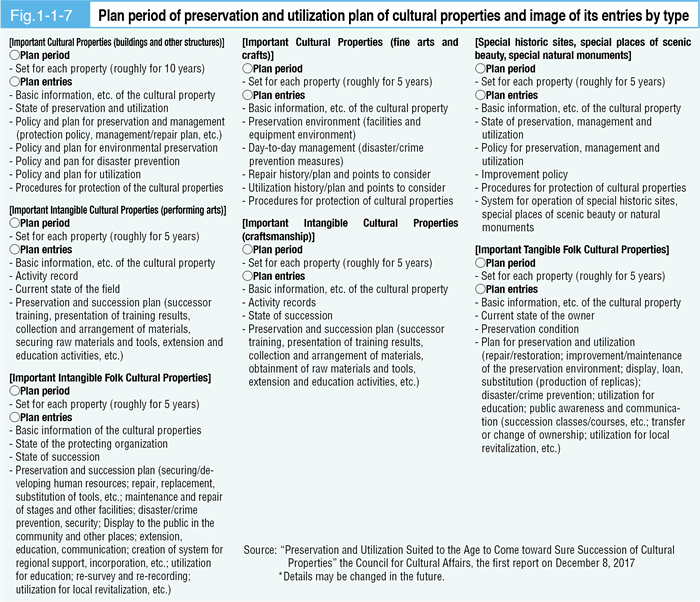
3.Strengthen the Driving Force of Administration of Regional Cultural Properties
For local governments to promote the initiatives described above for further progress of administration of regional cultural properties, they will be required to perform services with more diverse knowledge and from broader perspectives. To this end it is essential to improve their promotion system. For individual local governments to advance plan-based initiatives, it will be important to ensure the integrity of culture administration including the arts and culture sector and comprehensive and integral initiatives considering other administrative fields such as landscape/town development and tourism.
For this purpose, the affairs for protection of cultural properties which are currently managed and executed by boards of education may be handled by the head of the local government under the ordinance if the local government finds it is effective for further improvement of the affairs concerning cultural properties (amendment of the Act on Protection of Cultural Properties and the Act on the Organization and Operation of Local Educational Administration)
However, management and execution of affairs concerning cultural property protection require environmental improvement to handle considerations for protection of cultural properties, which include expert/technical judgment and balancing with development activities. For this purpose, when the head of the local government handles the affairs, it is mandatory to set up a local council for protection of cultural properties consisting of people with excellent insight into cultural properties. In addition, promotion of assignment of personnel with expert knowledge to cultural properties departments, improvement of training to enhance expertise of the assigned personnel, thorough law compliance, improved transparency of cultural properties administration, and regular close collaboration/cooperation with school/social education departments are expected to help appropriate response based on the situation of the local government.
Currently, Cultural Property Protection Advisors who make a tour of inspection of cultural properties and provide advice to owners, etc. may be assigned at prefectures but will also be assigned at municipalities. This will create a system that facilitates activities of experts rooted in the community, which includes support for regular management and crime/disaster prevention.
Section 4 Cultural Programs toward the Olympic and Paralympic Games Tokyo 2020
1.Development of Cultural Programs
The Olympic and Paralympic Games are at once a sports festival and a culture festival. Various cultural activities including art competitions and exhibitions have been implemented in connection with the games. In recent years cultural programs have been often implemented for multiple years.
In this context, the Olympic and Paralympic Games Tokyo 2020 (Tokyo 2020 Games)will provide a great opportunity to transmit attractive cultural activities with rich regional characteristics to the world. It is important to spread cultural programs that contribute to regional vitalization and tourism promotion nationwide in cooperation with local governments, artists and other people all over the country.
Cultural programs including the Tokyo 2020 Cultural Olympiad and Beyond 2020 Program have already started toward Tokyo 2020 Games.
The initiatives authorize programs for rediscovery, succession and development of Japanese Culture, development of the next generation and creation of new culture and the arts, transmission of Japanese culture to the world and creation of legacies (cultural heritages)suited for a mature society, which we can present proudly to the next generation. MEXT also started authorization of beyond 2020 programs in May 2017.
These activities are expected to further promote Japan’s culture and the arts and foster the momentum of the Olympic and Paralympic Games all over the country.
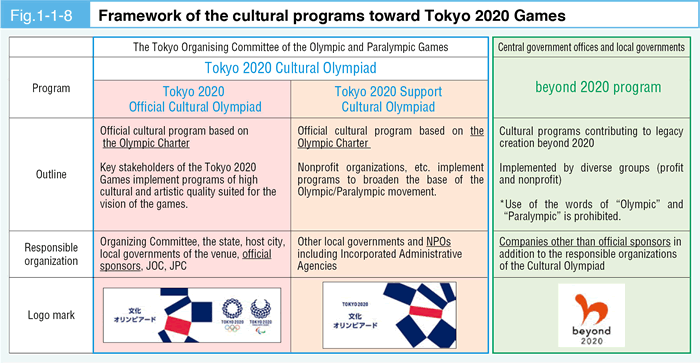
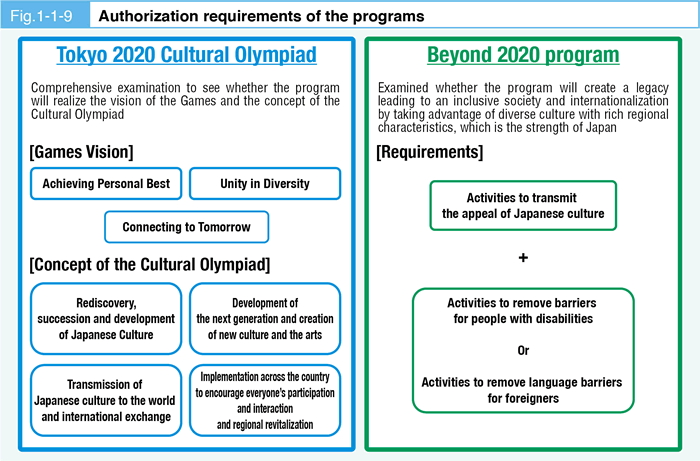
2.Toward Creation of Legacy Beyond 2020
Toward realization of a Nation Based on Culture and the Arts, MEXT will take the opportunity of the Tokyo 2020 Games to develop diverse culture and the arts and utilize cultural properties through support for local cultural and artistic activities and promote cultural programs.
In order to foster momentum for spreading cultural programs across the country, the ministry in cooperation with The Tokyo Organising Committee of the Olympic and Paralympic Games, relevant government offices and others worked to spread the authorization system and held a symposium in Toyama and Oita Prefectures to discover and transmit diverse cultures with rich regional characteristics. In addition, MEXT held a meeting to present the cultural programs implemented ahead of other programs in FY2017 in Yokohama, Kanagawa.
MEXT is also working to build a “Cultural Information Platform” to widely collect information of cultural programs across Japan and manage and summarize the gathered information on the Internet. Based on the information the ministry built and has been operating Culture Nippon*1 , a comprehensive portal site of cultural programs, on a trial basis since May 2017.
Toward creation of legacy beyond 2020, MEXT has been implementing various cultural programs through activities contributing to the internationalization of Japanese culture and realization of an inclusive society, and activities to discover and disseminate local cultural resources by recognizing about 100 Japan Heritages by 2020.
*1 Reference: http://culture-nippon.go.jp/ja/
(1)Major cultural programs hosted by the Agency for Cultural Affairs
- Culture NIPPON Symposium (photograph on left)
- Nippon Takaramono Project - Japan Heritage x Live Art (Photo on right)(Picture provided by Isao Horikiri)
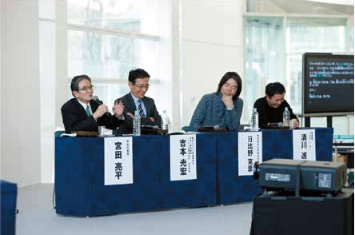
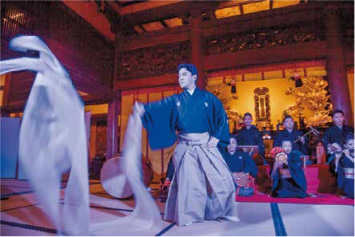
- National Cultural Program Press Center (Photo on left)(Picture provided by Kyodo News)
- Tokyo Suki Fes 2017 (Photo on right)(Picture provided by the Implementation Committee for New Concept “Ueno, a Global Capital of Culture”
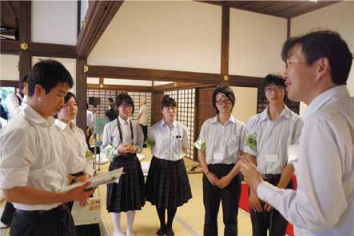
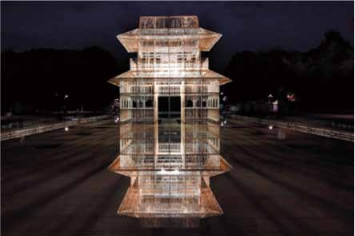
(2)Japan Heritage (examples of the heritages recognized in FY2017)
- Even Edo is not as busy as Esashi in May
- The town made prosperous by herrings - [Esashi Town, Hokkaido] - The Kitamae-Bune Sea Routes - Ports and Residences Built on the Dreams of Brave Seafarers - [Hakodate and Matsumae of Hokkaido, Ajigasawa and Fukaura of Aomori, Akita of Akita, Sakata of Yamagata, Niigata and Nagaoka of Niigata, Kaga of Ishikawa, Tsuruga and Minamiechizen of Fukui]
- Kurashiki Story starts from a cotton flower - a Textile Town weaving Japanese and Western Cultures - [Kurashiki, Okayama Prefecture]
- Yabakei Scenery - Traveling in the Sansui Scroll Painting of Nature [Kusu town, Nakatsu City, Oita Prefecture]
![Ubagami Daijingu Togyo Festival [Annual Celebration at the End of the Herring Fishing Season] (Esashi) Ubagami Daijingu Togyo Festival [Annual Celebration at the End of the Herring Fishing Season] (Esashi)](/b_menu/hakusho/html/hpab201701/detail/__icsFiles/artimage/2019/06/14/c_pbl_14_4/1418065_006.jpg)
Ubagami Daijingu Togyo Festival [Annual Celebration at the End of the Herring Fishing Season] (Esashi)
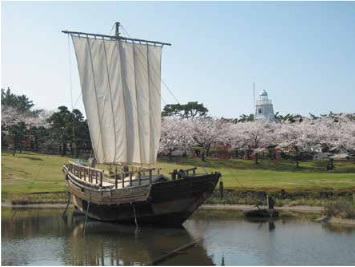
Hiyoriyama Park (Sakata)
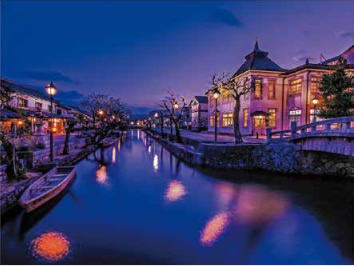
Town weaving Japanese and Western Cultures, Kurashiki Bikan Historical Area

The Stone Pillars (Kusu Town)
Column No.01 Succeed and Communicate the history of Meiji
2018 is the 150th year counting from the first year of Meiji (1868). In the Meiji Period Japan took the first step toward a modern nation state, made a wide range of efforts for modernization and built the basic form of the state.
The efforts include introduction of the cabinet system, establishment of the Meiji Constitution, introduction of constitutional and parliamentary government, promotion of technological innovations and industrialization such as railway opening and the mail system, improvement of education such as introduction of compulsory education and establishment of women’s normal schools.
Young people including women studied abroad, absorbed knowledge and used the knowledge to develop technologies and culture that were not simple imitation of the West but also kept the beauty and tradition of Japan.
Seizing on the milestone of the Meiji 150th anniversary in 2018, the government together with local governments and private enterprises is carrying out various initiatives to think back to the Meiji Period and connect the experience to the future.
(Initiatives of MEXT)
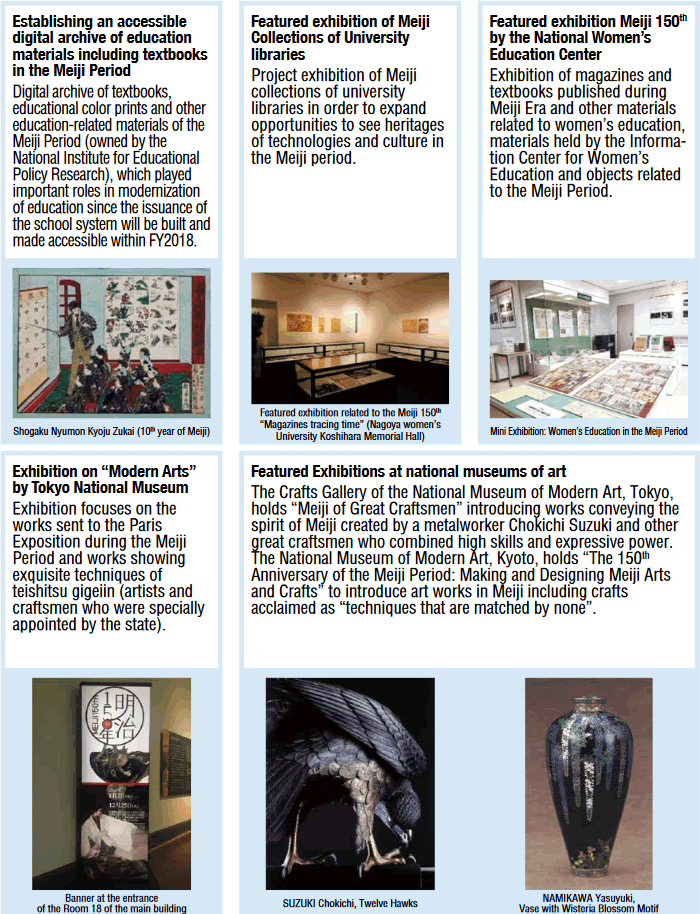
Column No.02 In 2018 the Agency for Cultural Affairs marks the 50th anniversary of its founding
The Agency was established in 1968 through a merger of the Cultural Bureau of the Ministry of Education and the Cultural Properties Protection Commission and marks the 50th anniversary in June 2018. During the 50 years the budget of the Agency increased 21.5 times from 5 billion yen in FY1968 to 107.7 billion yen (FY2018). A large number of people related to the agency have made efforts for the promotion of culture and the arts, which include improvement of cultural properties administration, development of culture-related facilities, development of arts and cultural policies at local governments and international cultural exchange.
According to a public opinion poll conducted by the Cabinet Office, the rates of participation in direct appreciation of culture and the arts and other cultural and artistic activities were 59.2% and 28.1% respectively (2016). Concerning the details of direct appreciation, more respondents answered movies, music and visual arts. Other cultural and artistic activities cited by a larger number of respondents were participation in local performing arts and festivals, and culture lessons such as dance, tea ceremony, flower arrangement and calligraphy.
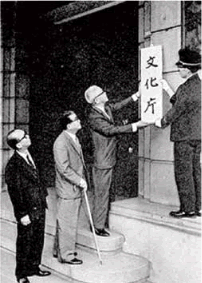
Establishment of the Agency for Cultural Affairs
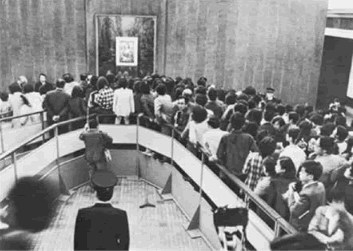
Mona Lisa Exhibition hosted by the Agency in 1974
Major events
- 1968: Establishment of the Agency for Cultural Affairs (by merger of the Cultural Bureau of the Ministry of Education and the Cultural Properties Protection Commission
Yasunari Kawabata was awarded the Nobel Prize for Literature - 1969: Relocation of the Tokyo National Museum of Modern Art to the current place
- 1970: Enactment of the Copyright Law
- 1975: Amendment of the Law for the Protection of Cultural Properties
- 1986: Start of National Culture Festival
- 1990: Foundation of the Japan Arts Fund (public and private fund)
- 1992: Ratification of the World Heritage Convention
- 1994: Kenzaburo Oe was awarded the Nobel Prize for Literature
- 1996: Amendment of the Law for the Protection of Cultural Properties
- 1997: Start of Media Arts Festival
- 2001: Promulgation of the Basic Act for the Promotion of Culture and the Arts
- 2006: Implementation of the Convention for the Safeguarding of the Intangible Cultural Heritage
- 2016: Decision to relocate the Agency to Kyoto
- 2017: The Basic Act for the Promotion of Culture and the Arts was amended to establish the Basic Act on Culture and the Arts *2
*2 See Part 1 Special Feature 1 Section 1
お問合せ先
Education Policy Bureau Policy Division
-- 登録:令和元年06月 --